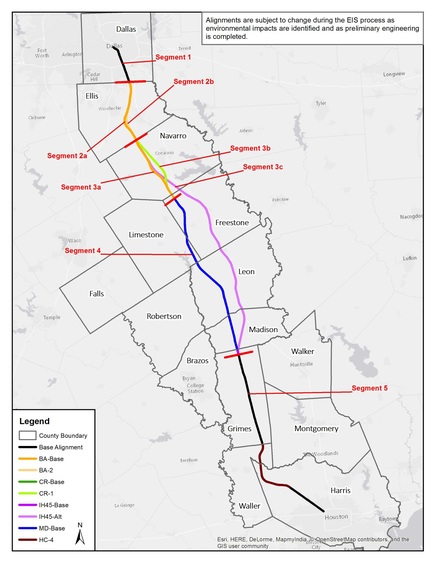FRA Identifies Draft EIS Alignment
Alternatives for the Dallas to Houston High-Speed Rail Project
The Federal Railroad
Administration released its Alignment
Alternatives Analysis Report. The report identifies the potential
alignments that will be evaluated in the Environmental Impact Statement (EIS) for
the Dallas to Houston High-Speed Rail Project proposed by Texas Central
High-Speed Railway (TCR). Following a
comprehensive analysis of the major corridors proposed for the project, FRA has
narrowed the focus of its environmental analysis to six potential
alignments. The report, released on
FRA's web site here, is the next step in the environmental
analysis required by the National Environmental Policy Act (NEPA).
FRA's analysis began with
22 potential route alternatives in five major geographical areas, and evaluated
them, using NEPA screening criteria, to compare their potential to create
impacts to the human and natural environment. The five major geographical areas
are:
·
Corsicana Area
·
Bardwell Area
·
I-45 Area
·
Middle Area
·
Hockley Area
The driving purpose
behind FRA's analysis of the project is to identify impacts to the environment
and communities along the potential alignments. FRA will ultimately issue a Draft EIS detailing
this information for the public and that will be discussed at future public
hearings on the project.
From the 22 potential route
alternatives, FRA determined that 6 potential alignments will be carried
forward for more detailed evaluation in the Draft EIS, as illustrated below.
Table 1 Potential Alignments

Figure 2 Potential Alignments

In its Alignment Alternatives Analysis Report,
FRA describes the detailed process it used to review and analyze the potential route
alternatives. In addition, as required by NEPA, FRA will evaluate a No Build
Alternative in the Draft EIS. The No Build Alternative will serve as the
comparison against which the 6 potential alignments or “build alternatives”
will be evaluated.
For More Information
FRA posts project
reports, maps, and updates as new information is available on FRA’s project
website: https://www.fra.dot.gov/Page/P0700.
|